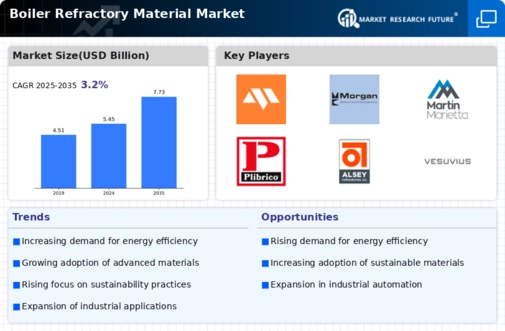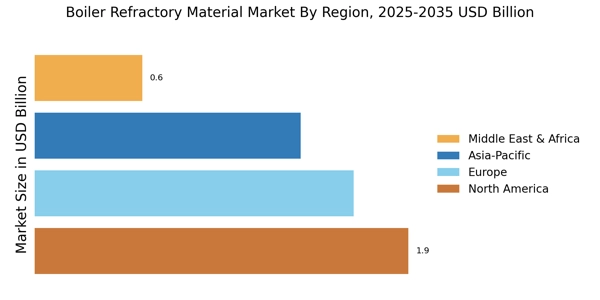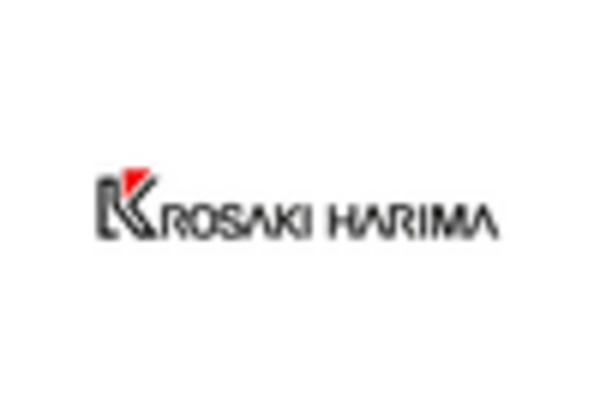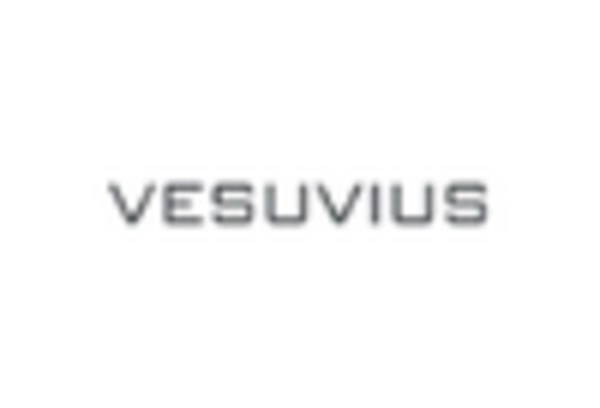Expansion of Industrial Applications
The Boiler Refractory Material Market is witnessing an expansion in its applications across various industrial sectors. Industries such as petrochemicals, cement, and metallurgy are increasingly utilizing advanced refractory materials to withstand extreme temperatures and corrosive environments. This diversification of applications is expected to drive market growth, as these sectors require reliable and durable materials to ensure operational efficiency and safety. For instance, the cement industry alone is projected to consume a significant share of refractory materials, with estimates suggesting a growth rate of around 6% annually. As industries continue to evolve and expand, the demand for specialized refractory materials tailored to specific applications is likely to increase, further stimulating the Boiler Refractory Material Market.
Increasing Demand for Energy Efficiency
The Boiler Refractory Material Market is experiencing a notable surge in demand driven by the global emphasis on energy efficiency. Industries are increasingly adopting advanced refractory materials to enhance the thermal efficiency of boilers, thereby reducing energy consumption and operational costs. This trend is particularly evident in sectors such as power generation and manufacturing, where energy costs constitute a significant portion of operational expenses. According to recent data, the energy efficiency market is projected to grow at a compound annual growth rate of approximately 8% over the next five years. Consequently, the adoption of high-performance refractory materials is likely to play a pivotal role in achieving these energy efficiency goals, thereby propelling the Boiler Refractory Material Market forward.
Regulatory Pressures for Emission Reductions
The Boiler Refractory Material Market is significantly influenced by regulatory pressures aimed at reducing emissions and enhancing environmental sustainability. Governments worldwide are implementing stringent regulations to limit greenhouse gas emissions from industrial processes, prompting industries to invest in advanced refractory materials that can withstand higher temperatures and improve combustion efficiency. This shift is particularly evident in the power generation sector, where compliance with emission standards is critical. As industries strive to meet these regulatory requirements, the demand for high-performance refractory materials is expected to rise, thereby contributing to the growth of the Boiler Refractory Material Market. The market is anticipated to witness a compound annual growth rate of approximately 5% as a result of these regulatory dynamics.
Rising Investment in Infrastructure Development
The Boiler Refractory Material Market is poised for growth due to rising investments in infrastructure development across various regions. Governments and private entities are increasingly allocating funds for the construction and upgrading of power plants, industrial facilities, and manufacturing units. This trend is particularly pronounced in emerging economies, where rapid industrialization is driving the need for efficient and reliable boiler systems. As new facilities are constructed and existing ones are retrofitted, the demand for high-quality refractory materials is expected to increase. Market analysts project that infrastructure investments will contribute to a growth rate of around 7% in the Boiler Refractory Material Market over the next few years, highlighting the potential for expansion in this sector.
Technological Innovations in Refractory Materials
Technological advancements are playing a crucial role in shaping the Boiler Refractory Material Market. Innovations in material science have led to the development of new refractory formulations that offer enhanced performance characteristics, such as improved thermal stability and resistance to thermal shock. These advancements are particularly relevant in high-temperature applications, where traditional materials may fail. The introduction of nanotechnology and advanced composites is expected to revolutionize the market, providing solutions that meet the stringent demands of modern industrial processes. As industries seek to optimize their operations, the adoption of these innovative refractory materials is likely to increase, thereby driving growth in the Boiler Refractory Material Market.


















Leave a Comment